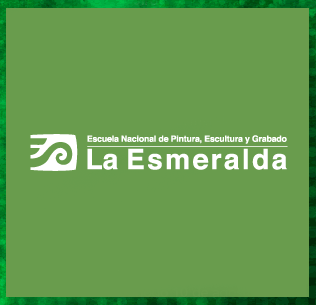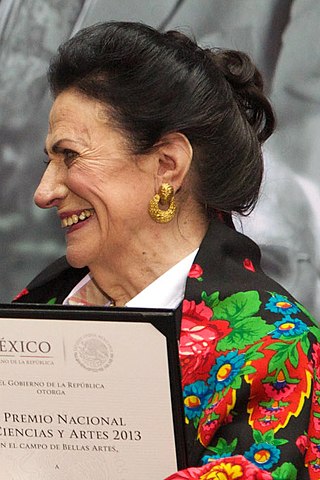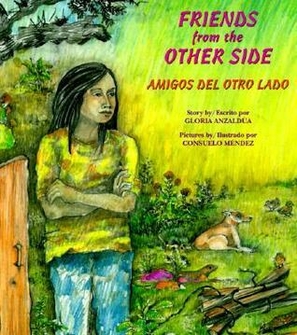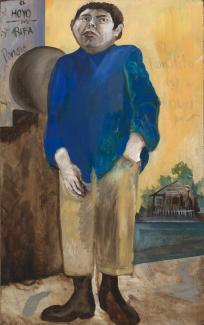José Antonio "Tony" Burciaga was an American Chicano artist, poet, and writer who explored issues of Chicano identity and American society.

Jorge González Camarena was a Mexican painter, muralist and sculptor. He is best known for his mural work, as part of the Mexican muralism movement, although his work is distinct from the main names associated with it. His major works include the mural on the main administration building of the Monterrey Institute of Technology and Higher Studies and a mural created for the Universidad de Concepción in Chile. He also created easel works, one of which, La Patria, was well known in Mexico as it was used on the cover of free textbooks from the 1960s into the 1970s. Recognitions for his work include the Premio Nacional de Arte, membership in the Academia de Artes and the Ordine al Merito della Repubblica Italiana, grade Commendatore from the Italian government.

La Esmeralda or Escuela Nacional de Pintura, Escultura y Grabado (ENPEG) is a Mexican art school founded in 1927 and located in Mexico City.

Ángela Gurría Davó was a Mexican sculptor. In 1974, she became the first female member of the Academia de Artes. She is best known for her monumental sculptures such as Señal, an eighteen-meter tall work created for the 1968 Summer Olympics. She lived and worked in Mexico City.

Jason Villegas is currently a San Francisco based contemporary artist. He has exhibited across the United States and internationally. Villegas' work utilizes a wide spectrum of mediums including sculpture, installation, painting, drawing, textile, video and performance. He has created his own artistic realm and visual language in which to explore concepts such as globalism, evolution, sexuality, cosmology, and consumerism. Motifs in Villegas' artworks include fashion logos, animal hybrids, weaponry, sales banners, clothing piles, anuses, cosmic debris, taxidermy, bear men, amorphous beasts, religious iconography, and party scenarios.

The Chicano Art Movement represents groundbreaking movements by Mexican-American artists to establish a unique artistic identity in the United States. Much of the art and the artists creating Chicano Art were heavily influenced by Chicano Movement which began in the 1960s.
Willie Herrón III is an American Chicano muralist, performance artist and commercial artist.

Friends from the Other Side / Amigos del Otro Lado (1993) is a bilingual (Spanish/English) Latino children's book written by Mexican American/Chicana scholar Gloria E. Anzaldúa and illustrated by Consuelo Méndez Castillo. It is loosely based on Anzaldúa's early life in South Texas and tells the story of a young Chicana girl, Prietita, living near the US-Mexican border who befriends and helps a young Mexican boy, Joaquín, who has recently immigrated.
Fidencio Castillo Santiago was a Mexican artist, educator, and a founding member of the Salón de la Plástica Mexicana.

Roberto Chavez is an American artist, known for his personally symbolic portraits, public murals and "funny-grotesque" paintings that reflect the multicultural landscape of Los Angeles. He was recently included in the Getty Center's Pacific Standard Time: Art in L.A., 1945-1980 and the Smithsonian’s Our America: The Latino Presence in American Art exhibits.

Chicano Art: Resistance and Affirmation was a traveling exhibit of Chicano/a artists which toured the United States from 1990 through 1993. CARA visited ten major cities and featured over 128 individual works by about 180 different Chicano/a artists. The show was also intended to visit Madrid and Mexico City. CARA was the first time a Chicano exhibit received major attention from the press and it was the first exhibit that collaborated between Chicanos and major museums in the U.S. The show was considered a "notable event in the development of Chicano art." Another unique feature of CARA was the "extensive planning" that attempted to be as inclusive as possible and which took place more than five years prior to the opening at Wight Art Gallery.
Santa Barraza is an American mixed-media artist and painter who is well known for her colorful, retablo style painting. A Chicana, Barraza pulls inspiration from her own mestiza ancestry and from pre-Columbian art. Barraza is considered to be an important artist in the Chicano art movement. The first scholarly treatment of a Chicana artist is about her and is called Santa Barraza, Artist of the Borderlands, which describes her life and body of work. Barraza's work is collected by the Mexic-Arte Museum, and other museums around the United States and internationally. She currently lives in Kingsville, Texas.
Melesio "Mel" Casas was an American artist, activist, writer and teacher. He is best known for a cycle of complex, large-scale paintings characterized by cutting wit, incisive cultural and political analysis, and verbal and visual puns that he called Humanscapes, which were painted between 1965 and 1989. Only a few of these Humanscapes address Chicano topics, though they are his most famous paintings, and "have appeared repeatedly in books and exhibitions" and "are rightfully regarded as formative icons of the Chicano art movement." Many of the Humanscape paintings, by contrast, are little known, as is much of the work Casas produced in the following quarter century.

Avenida Juárez is a street in the Historic Center of Mexico City flanking the south side of the centuries-old Alameda Central park.
Jesus Treviño, better known as Jesse Treviño, was a Mexican-born American visual artist. He essentially became a Chicano artist after he was wounded in Vietnam during the Vietnam War, which required him to learn how to paint with his left hand. Based in San Antonio, Texas, his paintings and murals largely depict the Mexican American/Chicano community of San Antonio, including cinemas and neighborhood shops, as well as people. He is best known for his photorealist paintings from the late 1970s and early 1980s, and for his large-scale mosaic murals made out of ceramic tiles, which he produced later in his career.
José Esquivel, a Chicano artist and commercial artist based in San Antonio, Texas, has been called "one of the earliest and most important Chicano artists in Texas." He is best known for his depictions of life in Chicano barrios. Esquivel also spent a lengthy period as a wildlife artist between 1973 and 1991, when he withdrew from Chicano art due to its association with radicalism. As a commercial artist, Esquivel worked primarily for City Public Service, San Antonio’s public utility company. By the time he retired in 1987, he was the supervisor of the art department. His best and most influential work was connected to the Chicano Movement, and it is included in a number of prominent collections. Esquivel was also a co-founder of the San Antonio-based Con Safo art group, which was one of the earliest and most important Chicano art groups in the country.

San Anto Cultural Arts (SACA) is an American 501(c)(3) art nonprofit founded in 1993 in San Antonio, Texas, U.S.. They operate two programs: the community mural and public art program (CMP), and El Placazo Community Newspaper and mentor program.

A Chicano mural is an artistic expression done, most commonly, on walls or ceilings by Chicanos or Mexican-American artists. Chicano murals rose during the Chicano art movement, that began in the 1960, with the influence of Mexican muralism and the Mexican Revolution. The murals are an illustration of Chicano’s ethnic pride or a form of activism against police brutality, social issues, political issues, and civil rights issues. It started being done by young Chicano artists in commonly marginalized neighborhoods, schools, and churches, demonstrating cultural art and ideas. The murals are characterized by their art style of bright color, religious symbols, and cultural references to Mexican and Mexican American history. Chicano murals have been and are historically found in the Southwest states like Texas, Colorado, and most famously, California, where the national landmark Chicano Park is located. The popularity of the Chicano Murals has allowed a sense of community, culture, activism, and storytelling about elements of being Chicano. Various states are currently looking to preserve and restore some murals as they carry historical meaning for the geographical community and the Mexican-American community.

Ruth Leonela Buentello is an American Chicana Artist. In 2019, she was named as a participant in the Joan Mitchell Foundation residency program. In 2017, she was awarded the Joan Mitchell Foundation Painters & Sculptors. She was the third Efroymson Emerging Artist in Residence sponsored by the University of Michigan.












